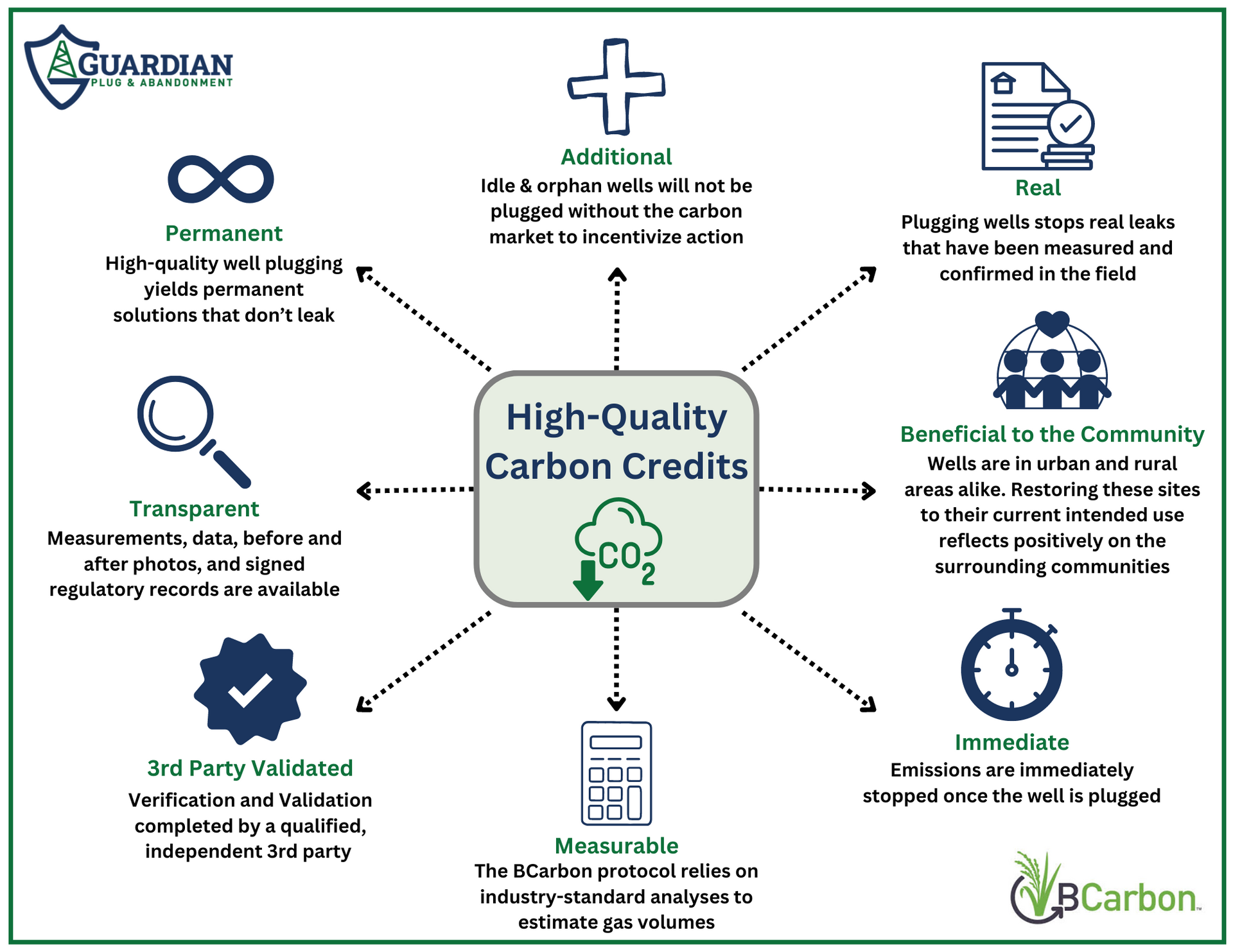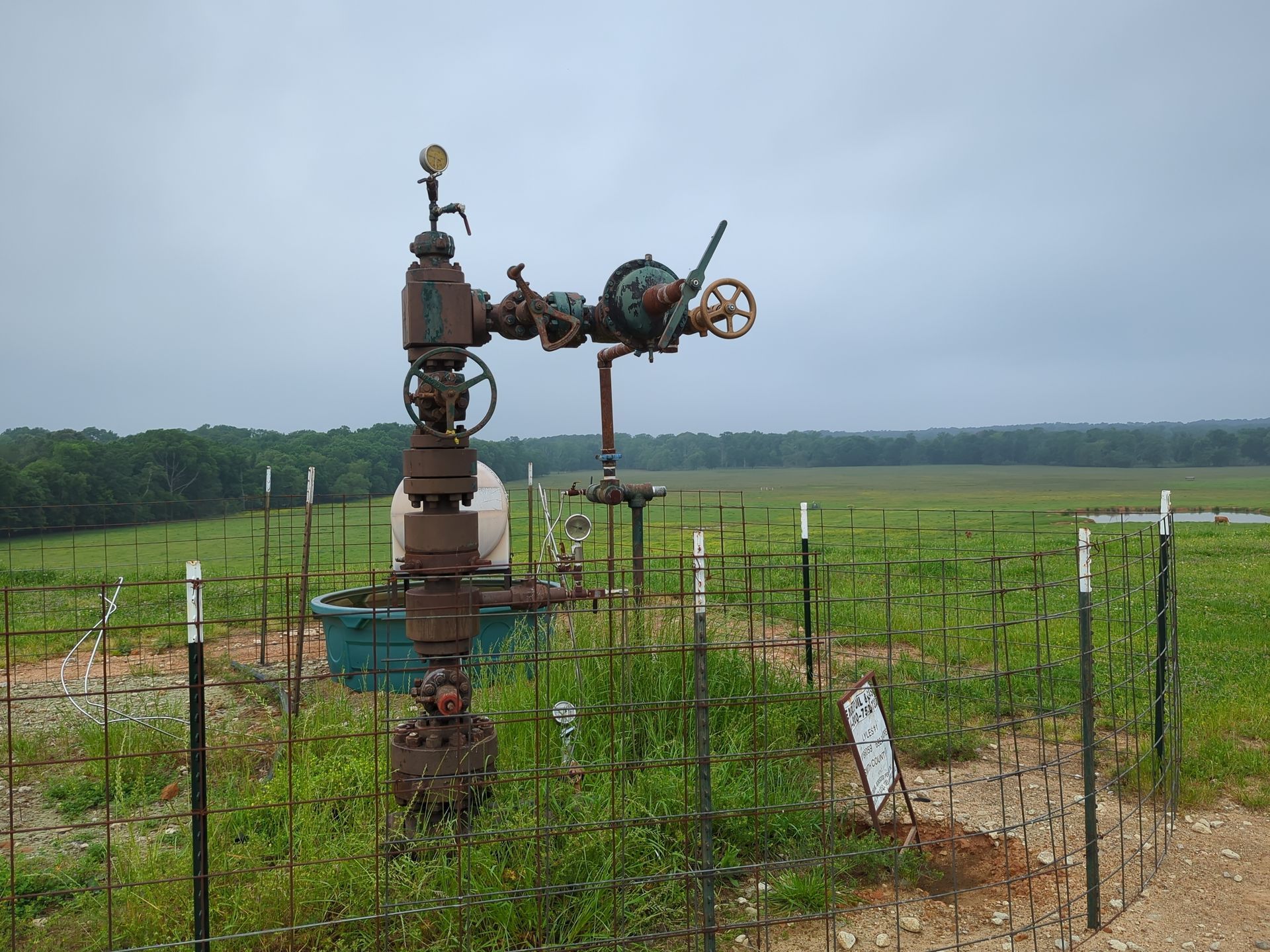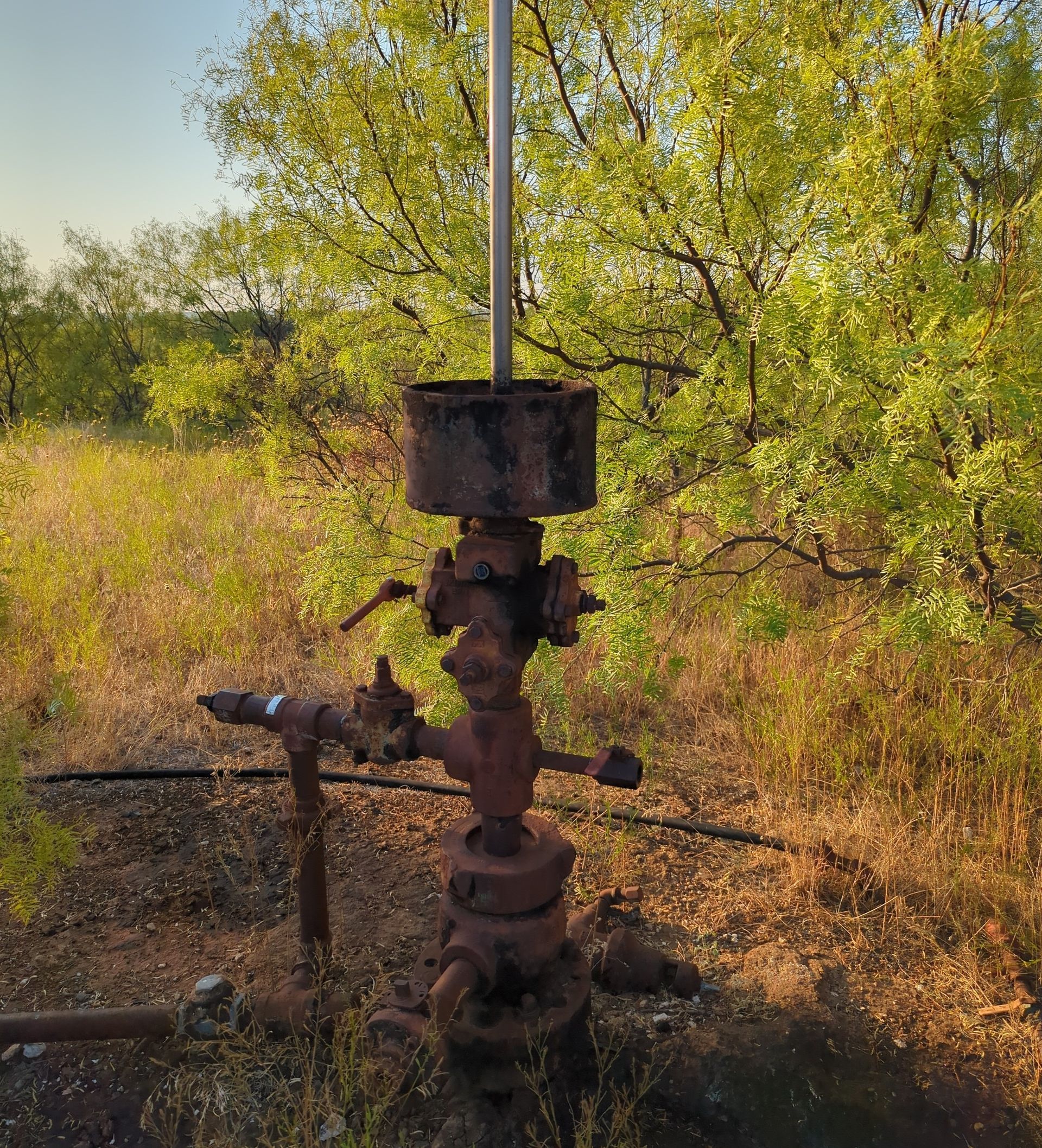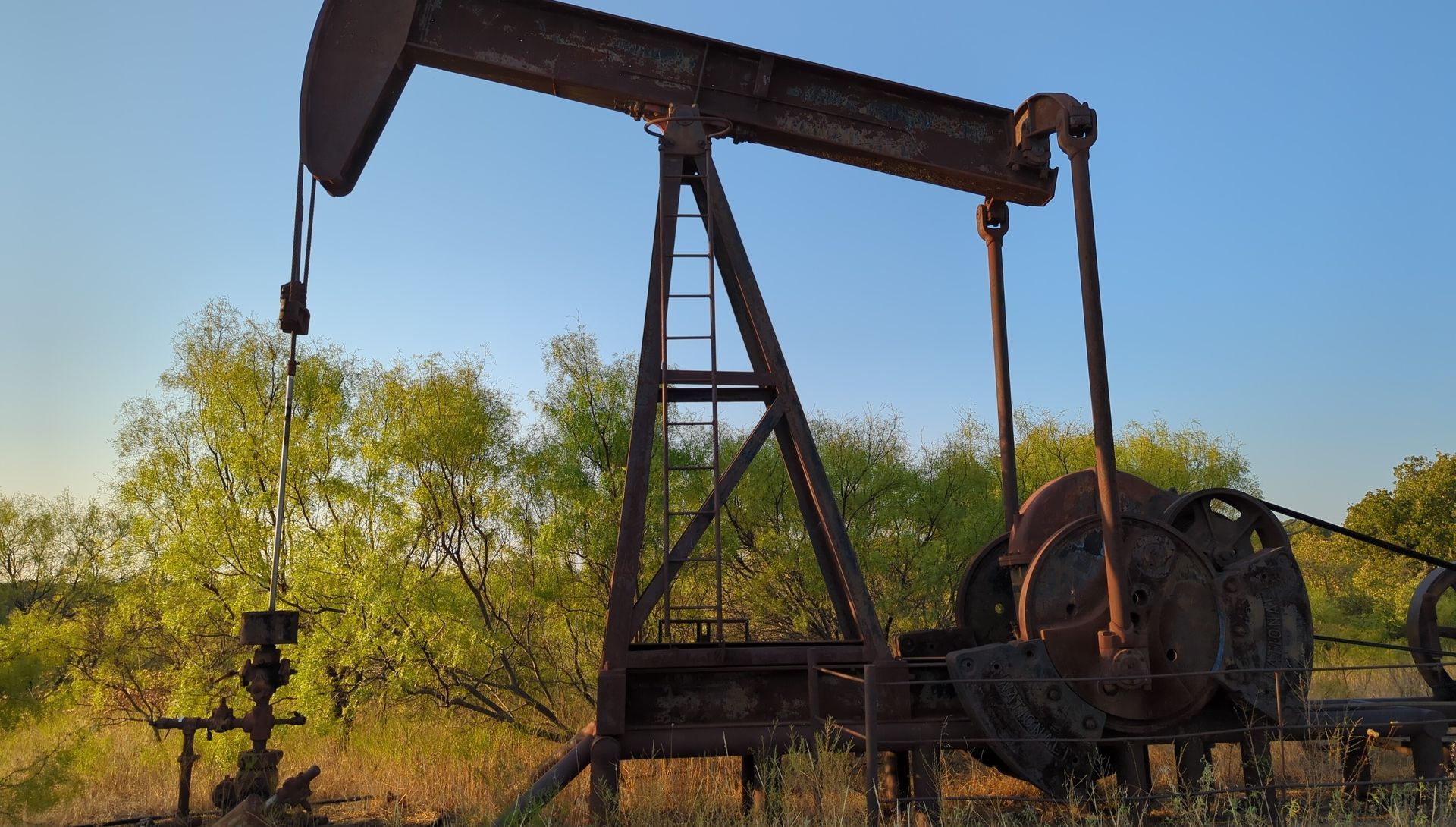Blog

Carbon credits (also often called “offsets”) represent one ton of CO2 emissions reduced from the atmosphere. Companies buy these credits and retire them to offset their own annual carbon footprint, after reducing emissions as much as possible internally. In a perfect world, reducing a carbon footprint by one ton has the equivalent climate impact as buying one carbon credit. But is this true? Does one carbon credit actually equal one ton of carbon emissions reduced from the atmosphere? Before we answer these questions, lets take a look at one of the protocols for generating carbon credits from plugging and abandoning oil and gas wells. BCarbon is a not-for-profit carbon registry with a protocol titled “Methane Capture & Reclamation,” (MCR) which is focused on permanently plugging gas wells that are sitting idle, abandoned, and/or orphaned. The protocol entails finding methane-leaking wells and permanently plugging them, resulting in what is known as avoidance carbon credits, seeing that future emissions have been avoided. The amount of credits generated relies on historical production data to estimate the volume of methane gas that would have leaked over the next 20 years. The calculations use an industry-standard decline curve model and leak rate model to determine future gas leak volumes and subsequently methane tonnage. Methane is then converted into CO2-equivalent (CO2e) to determine the number of carbon credits each well generates. The protocol requires that the plugging plans and emissions calculations are verified and validated by a neutral third party before and after the wells are plugged. The project also is not complete until 1) a post-plugging site assessment has determined that there are no more methane emissions and 2) the regulatory agency signs the plugging record stating that the well has been plugged in accordance with regulatory requirements. Finally, the protocol requires a site visit one year post-plugging to again confirm that there are no methane emissions. Now that we have a basic understanding of BCarbon’s methodology for plugging wells for carbon credits, lets look at some of the key ingredients of a high-quality carbon credit and figure out how reliable these P&A-generated credits actually are. Additional Additionality is the idea that the positive climate action project would not have taken place without the carbon market to incentivize action. While operators are supposed to plug the wells that they drill when they are done producing, the reality is not so clear. In fact, the United States Environmental Protection Agency (USEPA) estimates that there are about 3.5 million abandoned wells across the USA ( see here ). BCarbon’s MCR protocol deems a well additional if “at the time of plugging, no person or entity has a firm, non-extendable legal obligation to plug it either (a) by law, regulation, statute, court order or other government requirement, or (b) by private contract.” Real For a carbon credit to be considered real it must represent an actual, verifiable reduction in emissions. The BCarbon protocol requires that actual evidence of emissions from each well are documented and measured. The calculations that determine the quantity of credits use the same scientific rigor that is used for SEC reporting for determining remaining gas in reserve. Finally, the work of plugging the well is signed off by a regulatory agency, demonstrating the realness of the work performed. Permanent Permanence in the carbon market refers to how long the carbon benefit from a project will last. High-quality well plugging consists of multiple 100+ foot cement plugs, (a) cast-iron bridge plug(s), and high-density kill fluid combined with pressure testing to ensure that the well is permanently sealed off. Transparent Transparency refers to having all the information and data available to interested parties. It also includes a public record and accounting of the credits generated, transacted, and retired. Abundant documentation and record-keeping are required as part of the MCR protocol, including project plans, photos, calculations, regulatory records, and more. Once the credits have been issued, the project information is available on the BCarbon Registry to all interested parties. BCarbon generates the carbon credits on the blockchain, where all accounting is handled as public smart contracts. Immediate Carbon credit projects that are immediate mean those that instantly result in the proposed result, as opposed to taking years and sometimes decades for the results to occur. Plugging wells puts an immediate end to emissions, thus have a direct impact on the environment, and immediately producing the total volume of credits for a project. Measurable Measurability in the carbon market refers to having CO2e quantification methods that are reliable, accurate, data driven, and repeatable. The calculations needed to fulfil the MCR protocol are industry-standard equations for determining remaining gas reserves. The calculations rely on regulatory-reported gas production numbers that are publicly available. The decline curve and leak rate model spreadsheets established by BCarbon are also publicly available and generate consistent CO2e emissions reduction results when cross-examined. 3rd-Party Validated All carbon credit projects are required to have 3rd party validation and verification, which is a rigorous process that ensures the accuracy and eligibility of the project and claimed emissions reduction quantities. BCarbon’s MCR protocol requires that each project be validated prior to execution by a BCarbon-approved 3rd party validator and then verified once the project is complete. Beneficial to the Community Benefits of carbon credit project should go beyond just emissions reductions. Plugging wells has the opportunity to 1) create jobs, 2) increase the value of surrounding residential and commercial property, 3) improve human health conditions, 4) increase biodiversity, 5) remove potential liabilities to surrounding communities, and 6) improve air quality. The long-term success of the voluntary carbon market is highly dependent on having high-quality solutions that buyers can trust. Buyers ultimately want to purchase credits from projects that represent real emissions reductions with real, measurable solutions. The BCarbon Methane Capture & Reclamation protocol was designed to bring high-quality well plug and abandonment emissions reduction projects to the market. Guardian Plug & Abandonment is a project developer with BCarbon. If you’d like to learn more, reach out to us at info@plugandabandonment.com or check out our website at https://www.plugandabandonment.com/ .

Within the oil and gas well plugging industry, orphan wells have captured quite a bit of attention in the last 2-3 years. This is because of two main factors – 1) Large amounts of federal funding to locate, measure, and plug orphan wells and 2) carbon credit opportunities for plugging leaking orphan wells, particularly from ACR which had their methodology published in May 2023. Orphan Wells But what is an orphan well and why are these funding and carbon credit opportunities focused only on orphan wells? The consensus among all state and federal regulatory agencies is that an orphan well is no longer serving its purpose and it has no known owner or operator capable of properly plugging it. With no solvent operator, the well owner becomes the regulatory agency. The United States Geological Survey (USGS) conducted a study in 2021 and identified records of more than 126,000 orphan wells (see here ) and the number of undocumented orphan wells is estimated to be between 310,000 and 800,000 (see here ) according to a 2021 study by the Interstate Oil & Gas Compact Commission (IOGCC), but the real tally may be much higher. The reason they are the target of federal funding is because they are the responsibility of these government agencies. The reason ACR and the carbon industry have adopted orphan well methodologies is because of the clear additionality argument, stating that the business-as-usual case is that orphan wells are not plugged in a timely manner. Idle Wells The orphan well problem is large, but it is just the tip of the iceberg. Of the more than 4 million wells that have been drilled to extract oil and natural gas (see here ), the EPA estimates that there are a total of 3.7 million abandoned wells (see here ), which includes the orphan wells in the USGS study. Most idle wells were made idle with the hope of bringing them back to production when the economic situation improves. The reality, however, is that the majority of these wells are forgotten about. As is pointed out in this article , due to the complex and expensive process to plug wells, many operators “have simply opted to defer their [plugging] obligation by paying fees as low as a few hundred dollars per year.” Another option for operators of low producing and idle wells is to bundle up a package of wells and sell them to smaller operators that can work on thinner profit margins. In fact, many small operators will give away their wells to avoid the plugging liability. Outlook on the future As is pointed out in the IOGCC study, the number of idle wells “is a concern because of the potential for the wells to deteriorate over time or become orphans.” In an effort to improve operations in the oil and gas industry, the EPA issued its “Final Rule” in early 2024, which is aimed at reducing methane emissions. Among other things, this final rule increases routine emissions monitoring requirements, increases regulation on flaring and venting gas, requires improved greenhouse gas reporting, and imposes a methane tax for excess methane emissions. While many believe this is a step in the right direction for the industry, it also puts small to medium oil and gas operators in a pinch. Many don’t have the knowledge or resources to comply with these regulations, which will cause some to go bankrupt. When an oil and gas operator goes bankrupt, their wells become orphaned. Despite the efforts to plug orphan wells with federal funding and carbon credit motives, many experts in the industry fear that the number of orphan wells will still increase, not decrease.. Getting ahead of the problem Plugging orphan wells will certainly help clean up the industry’s legacy issues, but that solution is treating the symptom rather than solving the ongoing issue. Fortunately for the industry, solutions are coming to prevent future orphan wells. First is The Methane Emissions Reduction Program, which announced $350 million to 14 states to help measure methane emissions and plug marginal and idle conventional wells (see here ). This is a federal program aimed at “helping well owners and operators [to] voluntarily identify and eliminate methane emissions from low-producing conventional oil and gas wells…with disproportionately high methane emissions.” A Notice of Intent to make funds available to states was announced in February 2024 and implementation by the states is expected to begin in the Fall of 2024. Second are expanding carbon credit methodologies. In addition to orphan well methodologies, several registries are establishing methodologies that address idle and marginal wells. Of those is BCarbon , whose methodology titled “Methane Capture & Reclamation” was released in October 2023. This methodology applies to all leaking, non-producing wells that historically produced gas, with the objective of preventing current and future methane leaks. As is stated in the methodology, “the key underlying observation is that leaking wells eventually completely exhaust the gas that is potentially available…” The quantity of carbon credits generated relies upon an industry-standard decline curve analysis of the historical gas production data combined with a leak rate model that determines the quantity of methane that would have leaked over the next 20 years (i.e. the crediting period). Final thought These solutions certainly won’t fix the industry overnight, but they are adding to the list of innovative solutions to help clean up legacy issues. If you’d like to learn more, reach out to Guardian Plug & Abandonment at info@plugandabandonment.com or check out our website at https://www.plugandabandonment.com/ .

Project developers can plug orphan oil and gas wells and generate carbon credits. They must quantify methane emissions rates, take over the orphan well, and then plug it, following the regulatory requirements. Finding high-emitting orphan wells is going to be key to making these types of projects economical for project developers.

Federal programs are starting to require methane monitoring at wellheads. The IIJA funding for orphan well plugging requires methane emissions rates to be quantified. The USEPA has funding to study wellhead methane emissions rates from marginal, conventional wells. Finally, the USEPA Final Rule introduces increased regulations in the form of OOOOb and OOOOc that will require individual well sites to be monitored for emissions.

Many wells in the US have no gas pipeline to tie into. The associated gas production is either vented or flared off. Regulations are trying to reduce venting and flaring, but small operators in particular continue to vent large volumes of gas. One solution is to plug these wells and generate carbon credits based on the amount of gas production. Guardian Plug & Abandonment can help you execute the carbon project.

Oil and Gas exploration began in the mid-1800's. Since that time, over 4 million oil and gas wells have been drilled in the United States. Many wells produce for a few decades, but others produce for over 50 years. In fact, there are still some producing wells that were drilled over 100 years ago. Generally, the lifespan of a well looks something like the scenario below: In Northeast Texas and Northwestern Louisiana, the Rodessa Oilfield was discovered in 1936. Many wells were originally drilled by Texaco, a major exploration and drilling company. Peak production in the Rodessa field was over 12 million barrels of oil in 1937. Over time, production naturally declined. Eventually, many of these wells in the Rodessa field were no longer economic for Texaco to produce. Texaco plugged many of these wells, but most of the marginally-producing wells were sold to smaller operators that could work on thinner margins due to lower overhead costs. These small operators produced these old wells as long as they could. Eventually, their margins got too thin and they chose to sell the remaining, marginally-producing wells to a local mom and pop operating company because these wells are more of a plugging liability than an asset. The mom and pop operating company then continued to produce these wells for as long as possible. Over time and one by one, the wells stop producing enough to cover the costs of electricity, maintenance, and water disposal. Eventually, the mom and pop operators in the Rodessa field end up with 50 wells, but only 5 are producing. In Texas, after a well has stopped producing for a year, operators are required to plug it. Thus, to avoid plugging the other 45, the operating company reports that all 50 are still producing, and the amount of production they report is what the 5 remaining wells are actually producing. This is why the Rodessa field in Northeast Texas has hundreds of "active" well sites. Some are still marginally producing, but many are sitting there idle, waiting to be plugged. Many were drilled in the 1930's, while others were drilled decades later. Eventually for the mom and pop operator, production on the remaining 5 will no longer be economical. The state regulatory agency will come breathing down their necks and require that all 50 wells be plugged. Considering a plugging job with site restoration costs anywhere from $30,000 to $100,000 per well, do you think the mom and pop operating company will fork over $1.5 to $5 million to plug all 50 wells? Not a chance. So what does mom and pop operating do? Declare bankrupcy. All 50 wells end up as orphan wells, and the responsibility to plug them lies with the state regulatory agency through state and federal funding. This is why we have somewhere between 100,000 and 3 million orphan wells in the United States today. There is hope, though. Orphan wells have gotten lots of attention as of the last few years. The Federal government is providing $4.7 BILLION to plug orphan wells!!! That sum of money is FANTASTIC, but what are we going to do to stop the constant flow of FUTURE orphan wells? If you ask me, the federal funding to plug orphan wells is like forgiving student loan debt while issuing more loans to students 😳.... how helpful is that? The solution ------- CARBON CREDITS. Okay, so what is a carbon credit? One carbon credit represents 1 ton of CO2 equivalent from entering the atmosphere. By VOLUNTARILY taking action to reduce greenhouse gas emissions, we (as a society) can generate carbon credits. Companies such as CarbonPath , ZeroSix , BCarbon , Onyx Transition , and ClimateWells are trying to incentivize early well plugging. They have written specific methodologies that a project developer can follow to quantify greenhouse gas emissions reductions and therefore generate high-quality carbon credits. Their methodologies are based on quantifying the remaining reserves and/or gas emissions and determining how much gas would be emitted to the atmosphere from combusting these resources. By plugging these resources in the ground permanently, we AVOID future gas emissions. Hence, these carbon credits are considered "avoidance" credits, meaning they reduce future emissions from ocurring. Now, I know what you are asking. Who buys these credits? And how much are they worth? Well, in most of the US, the carbon market is unregulated. Companies are not "required" to meet carbon emissions targets yet . Currently, the market we operate on is the Voluntary Carbon Market (VCM). The VCM is where companies that pledge "net zero" or "carbon neutral" go to offset their carbon emissions. Each year, to be carbon neutral, companies must calculate their carbon footprint and purchase the carbon credits (technically called carbon offsets) in order to claim "carbon neutral" or "zero-emissions". The value of these credits is driven by the buyer, each of which will value credits differently. Some may value carbon credits generated from planting trees, while others may value improving refrigerant technology, and another may value directly sucking CO2 out of the air. Some companies may want to support providing improved cooking solutions to 3rd world countires, and others may want to support solar and wind energy projects. All of these methodologies in some form VOLUNTARILY reduce CO2 emissions to the atmosphere and are valid ways of generating carbon credits. We believe that avoidance credits generated from permanently plugging wells are some of the highest-quality carbon credits you can buy. All the data, photos, and regulatory signatures are held publicly on the blockchain, and all the transaction history and selling prices are as transparent as it gets. So I'll return to my question - How much are these well-plugging avoidance carbon credits worth? Maybe $20-$40 each as of now, but with the carbon maket expected to grow from $2 billion to $50 billion by 2030, you'd better believe that the price is going to rise. At Guardian Plug & Abandonment , we can help you learn how to plug wells for carbon credits. We are project developers. Additionally, we are Qualified Measurement Specialists and can detect and quantify methane emissions from your wells. Feel free to reach out with questions at info@plugandabandonment.com or visit our website at https://www.plugandabandonment.com/ .

